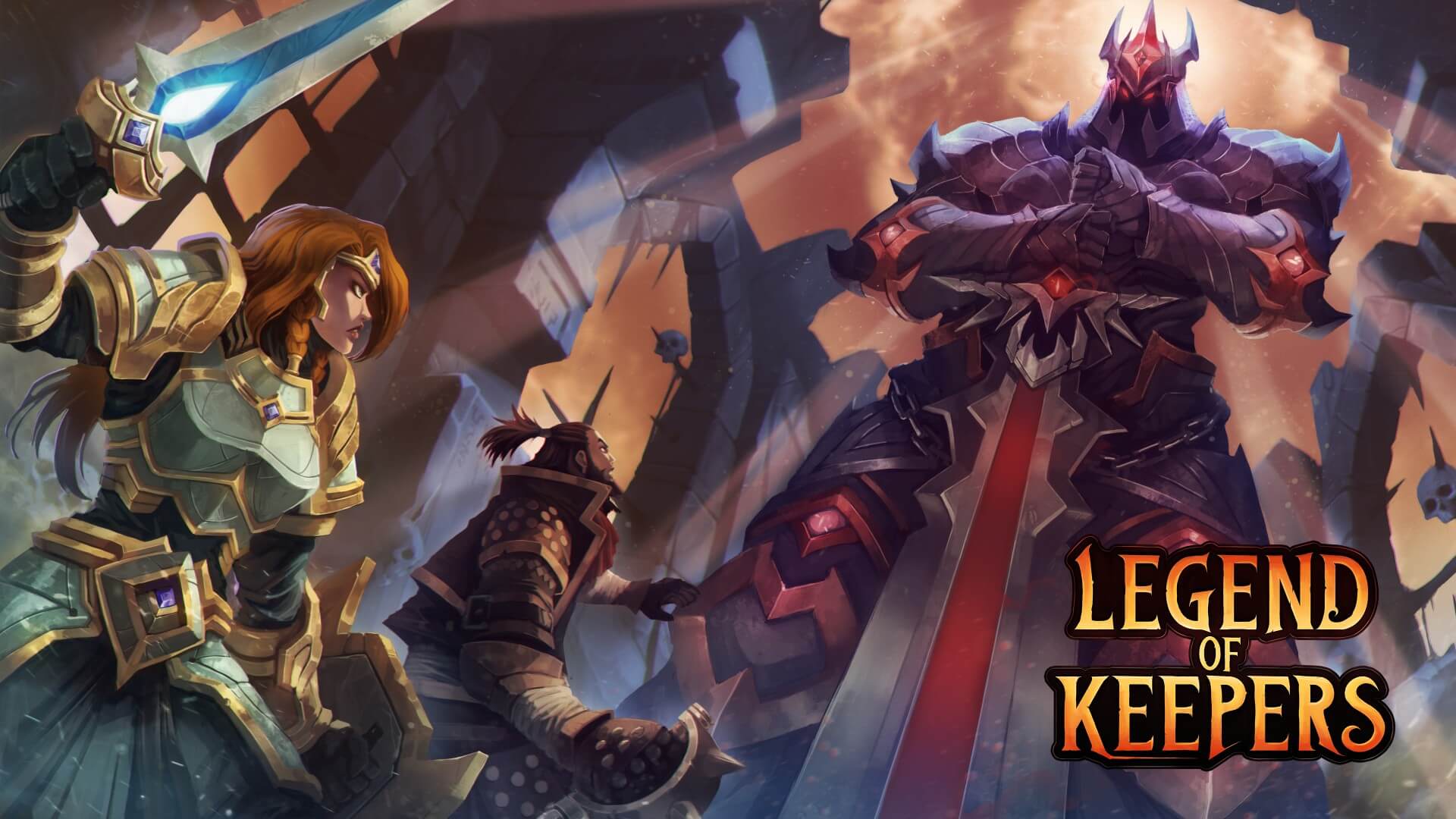A combination of a roguelike and a dungeon management game, Legend of Keepers is a devilishly fun diversion. The Finger Guns Review.
If you’ve been playing video games for any length of time, you’ve probably raided your fair share of dungeons. They’re a staple of the entire medium. The heroes enter, they kill waves of monsters, maybe unlock a new skill, defeat the boss and collect the loot. It’s far rarer to see this situation from the other perspective, in which we play as the dungeon defenders themselves. Even those that do exist tend to follow the same formula as the OG in the genre, Dungeon Keeper. Legend of Keepers from Goblinz Studio is a game that does something different with this concept. Combining strategic dungeon defence with roguelike elements, it’s a fun, content rich title.
In Legend of Keepers, you play as the newest managerial recruit to the ‘Dungeons Company’. It’s their job to protect dungeons from would-be heroes that attempt to plunder the loot located in their depths. In order to do so, you’ll need to recruit monsters, set traps and cast spells to defeat or drive off the invading forces. After an introduction that’s run through the lens of a corporate induction, you’re put to work as the strategic manager over your first dungeon.
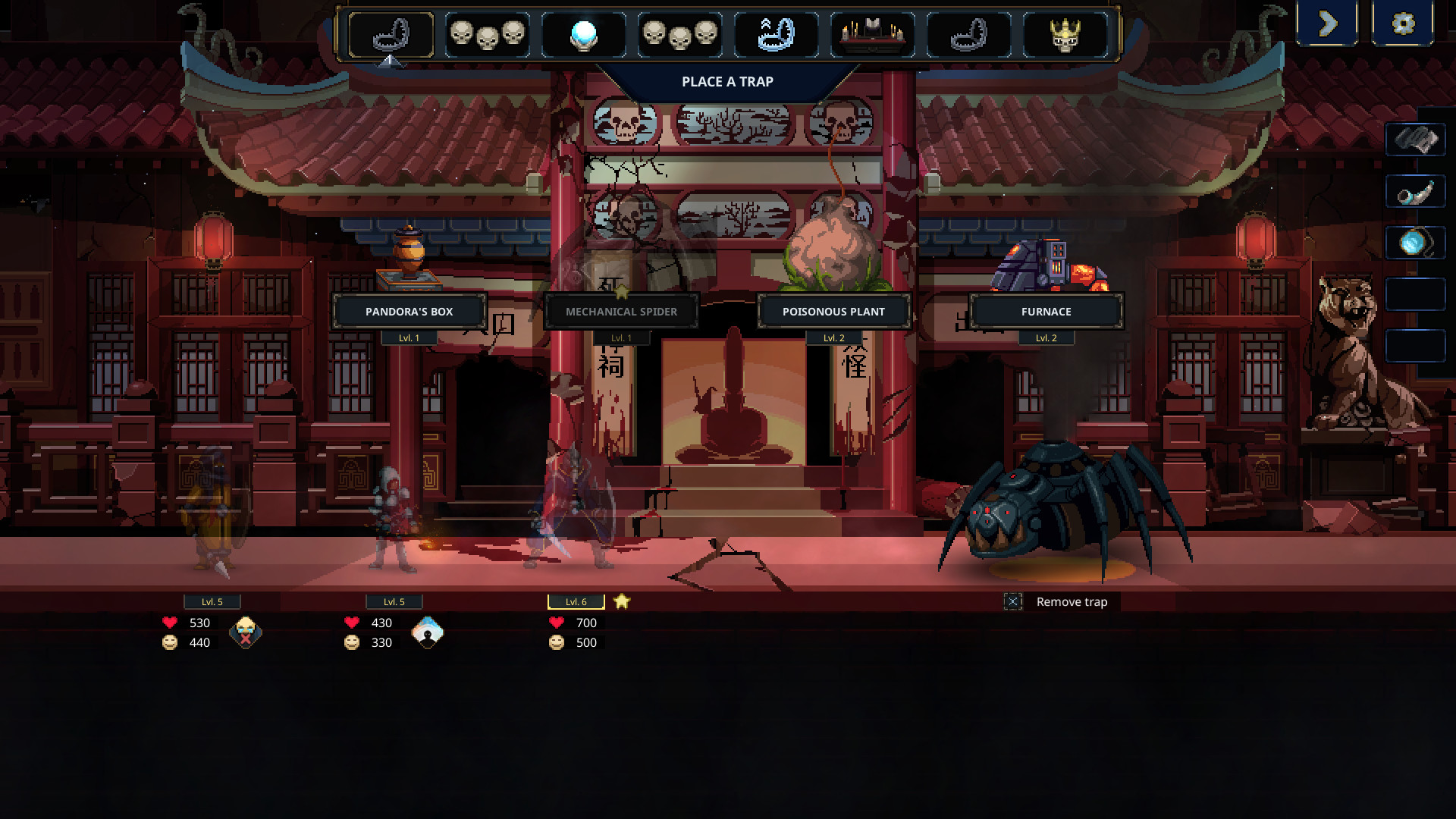
Legend of Keepers is separated across several dungeon levels across the land that act like roguelike runs. The aim of each level is to survive for a set number of weeks. At the start of each run, you’re granted a small group of monsters, an array of traps and spells. It’s the player’s job to utilise this starting set as best they can while building on it over time to repel ever stronger groups of heroes. If a group of heroes manage to vanquish all your monsters, defeat your boss and plunder the loot, the run is over and you’ve got to start the dungeon from scratch.
Each new week of the game presents something new to do. This might be a singular event to overcome or a selection of which the player can only choose one. Traders can visit the dungeon, offering to sell new traps or monsters. Vampires might arrive, demanding blood as tax in return for gold. You might get the opportunity to send some of your monsters on a raid to nearby towns in hopes of pilfering a new artefact. There’s opportunities to level up your monsters, improve your traps and cast de-buffs on anyone brave enough to step foot in your turf.
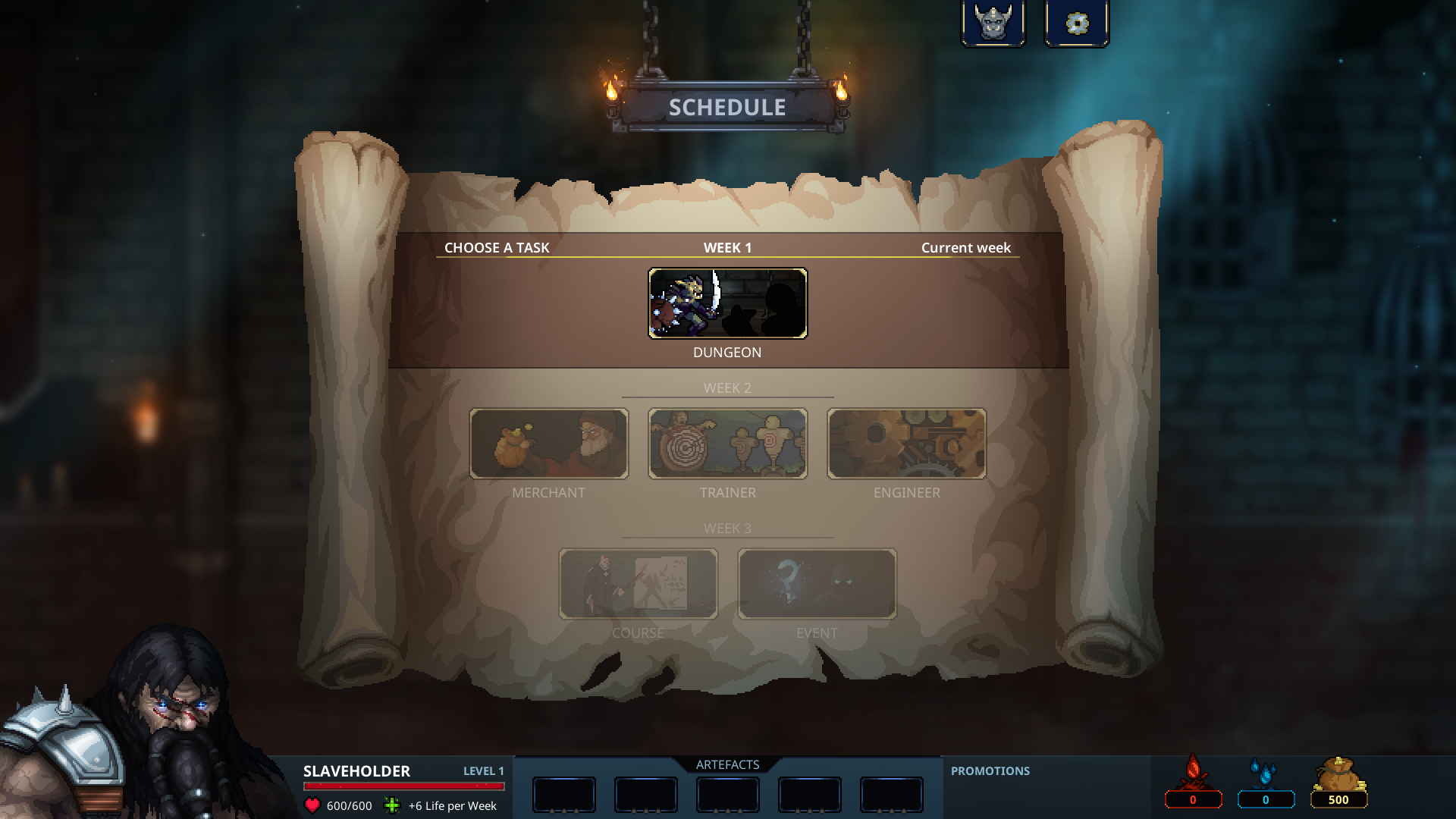
There’s also the chance you’ll get served with a mystery event in Legend of Keepers, presented by a question mark icon. There’s a wide variety of these which have small narrative elements that can be both positive or negative. Maybe a minion has found a mystery potion – do you take it from them and sell it or encourage them to drink it? There’s a chance a monster might get injured doing something stupid and end up injured for 10 weeks, putting them out of commission. Perhaps the dungeon chef has found a new recipe which requires the sacrifice of one of your minions – will you oblige? These events have been well balanced – you’ll find as many beneficial events as detrimental activities – so there’s a risk/reward system in place that’s constantly tempting. Do you choose to take part in a mystery event instead of an event where you know what you’re getting? It’s up to the player and how lucky they feel.
All of these weekly occurrences are underpinned by 3 types of currency – hero tears, blood and gold. Each have their own use and can be earned and spent in different ways. Your accumulated values for each of these currencies will determine your ability to deal with hardships that might come your way. The fastest way to earn these goodies is by defeating the heroes that are rocking up to your dungeon.
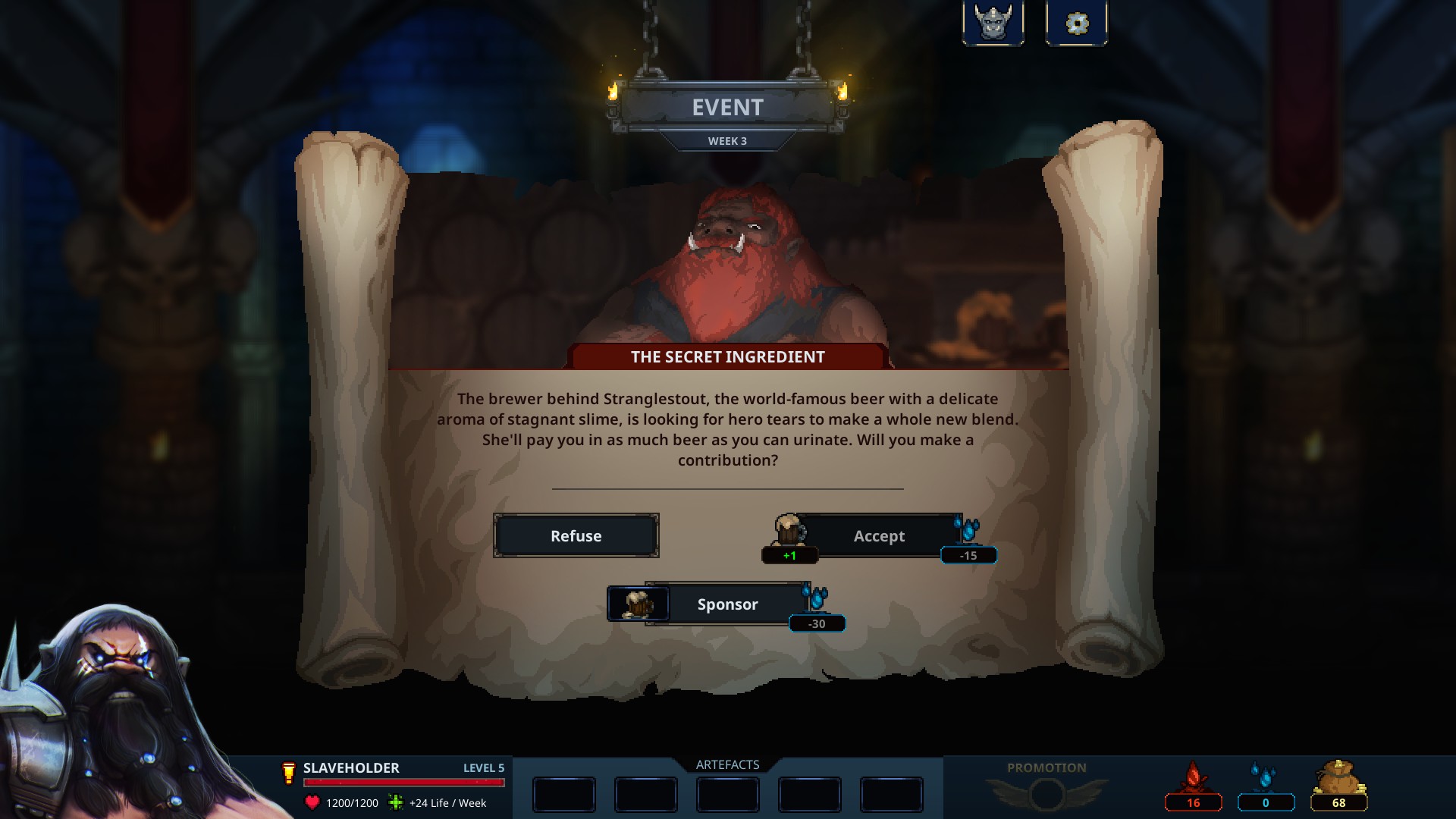
Every few weeks, a group of 3 heroes will attempt to raid the dungeon. These groups come in a few different difficulty levels with ‘Champions’ being the most challenging. The higher the difficulty, the better the reward for successfully vanquishing them. Each hero type has their own unique attacks, stats, strengths, weaknesses, health and morale. It’s the dungeon master’s (sic. the Legend of Keepers player’s) job to repel these invaders. This can be achieved in 2 ways – reducing their health points to zero, thus killing them, or reducing their morale to 0, which breaks their spirit and makes them run away.
Each hero encounter in Legend of Keepers is broken down into several stages. There’s a few constants – there’s always 2 rooms of monsters, a trap room, a boss room as the finale and a spell room – but the order of the rooms can be different. The variety of rooms expands as you progress through the game. Rest rooms, dungeon disaster rooms and intern offices (occupied by a big monster you obtain via promotion) are all added to the structure.
Before any action can begin against the invading heroes, the player gets to set out their defences. In this preparation section, you get to view the heroes, the order in which they’re standing (which is deceptively important) and the structure of the dungeon rooms themselves. Starting from the left most room, the player can then decide on how best to defend their positions. In trap rooms, a trap can be set to do the most damage possible or debuff the heroes. Then, in monster rooms, the player can set out their own trio of defenders. The order in which the monsters are placed is statically vital to success in Legend of Keepers. Each hero’s attack can deal damage to 1 – front, back or middle – or all 3 monsters as an area attack. The player’s team of monster play by the same rulebook, attacking 1 or all 3 of the heroes at a time based on position. It’s the players job to decide where each unit is best suited. For example, if every hero in a pack has attacks which deal out damage to the beast at the rear, it makes sense to put your tank-like monsters at the back of the pack. This way, the 2 monsters towards the front can deal out damage while the tank takes the licks.
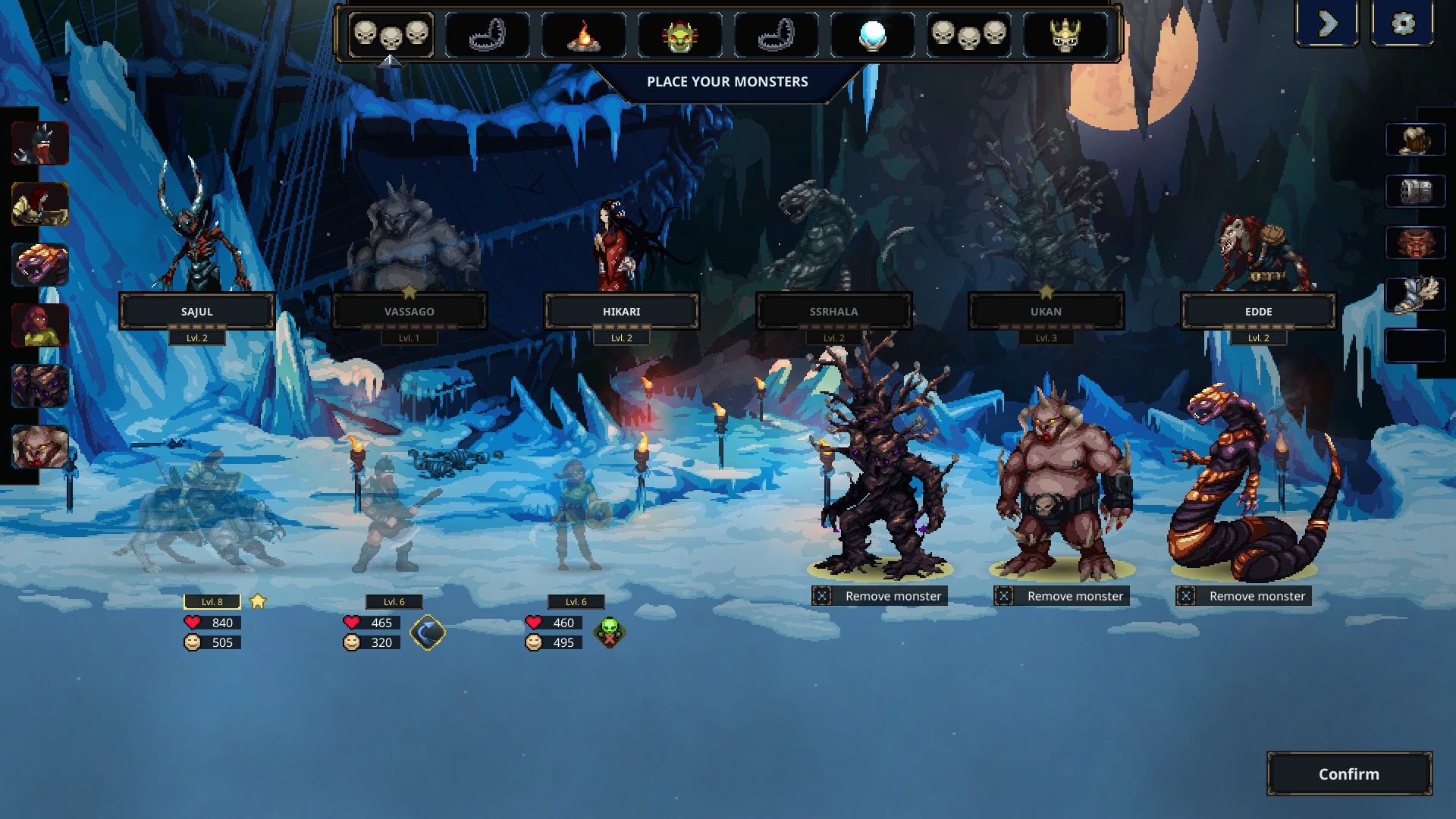
Another consideration while planning out the defence is your stock of artefacts. These are items which have profound passive effects on the sway of battle. Some of these artefacts give monsters in particular positions of the formation a buff, like increased health or speed. Others buff the entire monster trio if they’re all the same type of monster. A few of them offer a chance of resurrecting defeated monsters or can transform them into a different type upon death. Several can affect the power of
Once you’ve set out your defences and you’re happy with them, the action begins. The heroes will move from room to room, attempting to weather whatever storm you’ve set out for them. During this phase, the player can’t change what’s already been set in motion. What they can do is choose which attacks each monster uses when it’s their turn and can cast a spell/disaster when the heroes reach a room designated for it. The player can also control the attacks of the underboss, the big baddy that acts as the last line of defence over the dungeon and its loot. Defeat or terrify each hero and you’ll live to see another week. If the underboss falls, the run comes to an end.
The lumps you take during each hero encounter linger on, even in success. Monsters that fall in battle are reincarnated with full health but each time they do, they lose morale. If a monster’s morale decreases to zero, they become inactive for a number of weeks. To restore morale, monsters can be taken out of their room teams and placed in the garrison for a rest. Each week that passes will restore a little morale. If you’re hell-bent on keeping the units in their teams, you can also choose weekly events to restore some morale, like a visit from the therapist. The biggest scars from battle linger on the underboss. Their health doesn’t return to full fitness after battle and is regenerated over time. If your big boss took a beating in the last battle, it’s wise to accept a visit from the doctor if you get served one as a weekly event.

No matter whether a run ends in success or defeat, the underboss will gain some experience. This will eventually result in levelling up which increases their stats and affords them an ability point. These can be spent in a skill tree which not only effects them individually but can improve the chances of their minions too.
This experience doesn’t always feel like a reward, especially after a rough loss. Legend of Keepers is a roguelike and as such, you’ll sometime suffer some tough, soul crushing defeats. The persistent experience that carries over between runs does little to soothe the raw feeling after surviving 40+ weeks of a dungeon only to fall 1 attack away from defeating the final champion. This is all part and parcel of the genre I suppose – there’s a bit of a grind and some repetition does set in with later dungeons (per underboss) where the challenge really starts to ramp up. This is a roguelike though and you’ve got to accept an element of it which I think is admirably kept to a minimum.
Legend of Keepers has obviously used the months in Early Access to refine and balance the experience. That has paid off. What’s launching as the finished article certainly feels polished and play tested to the nth degree. This game always feels fair, even when you’re being dealt a crushing event which has gutted your treasury or put your best unit out of action. The nature of the game means that the very next event might be a blessing and game changer.
You can feel the amount of design work that has gone into perfecting the web of linked mechanics and systems too. It does take a little getting used to and is far deeper than it appears on the surface, but with experience, Legend of Keepers presents an excellent tactical and strategic game for those willing to put the time in. There’s a lot of content here too – including the new endless mode which is exactly what it sounds like.
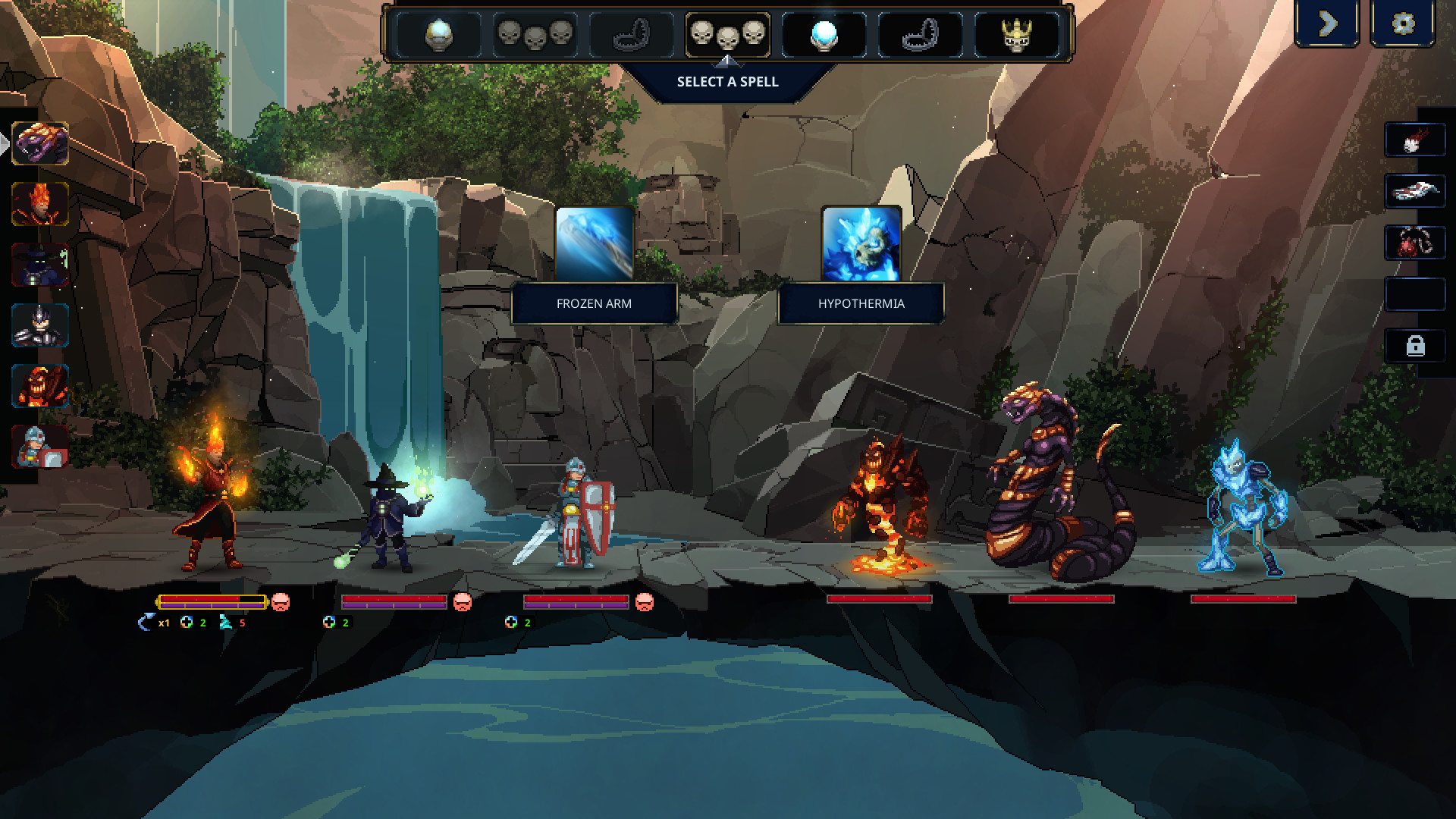
All of this is presented by some very attractive pixel art. Many of monster troops are inspired by legends, myths and video game favourites. The vast majority of the beasties in this game look suitably gross or unsettling with very few duds. The attacking heroes are similarly detailed although these take a more generic tone. Some of the heroic invaders are certainly paying homage to iconic protagonists, like the Djinn from Clash of Titans, but many of them sadly fall into hero tropes. I kind of wish Legend of Keepers had leaned into this a little more, paying homage or parodying more famous movie and video game protagonists. It might have affected the tone of the game somewhat but I don’t think it would have been detrimental given the whole game is played out through the scope of a dungeon defending corporate ladder climber.
That said, Legend of Keepers has thoroughly enthralled me during my review period with it and it’s one game I’ll be returning too regularly. That’s something that can’t be said of many games I get the opportunity to review.
Flipping the dungeon raid on its head, Legend of Keepers is a roguelike-strategy game hybrid that’s worth your time. It might have its tongue firmly pressed to its cheek at times but underneath its irreverent exterior is a deep and engrossing tactical gem. This is once corporate ladder you might want to synergise with.

Legend of Keepers is launching on PC and Nintendo Switch on April 29th, 2021.
Developer: Goblinz Studios
Publisher: Goblinz Games
Disclaimer: In order to complete this review, we were provided with a promotional code from the publisher. For our full review policy, please go here.
If you enjoyed this article or any more of our content, please consider our Patreon.
